load capacity FIAT FREEMONT 2012 Owner handbook (in English)
[x] Cancel search | Manufacturer: FIAT, Model Year: 2012, Model line: FREEMONT, Model: FIAT FREEMONT 2012Pages: 332, PDF Size: 5.61 MB
Page 81 of 332
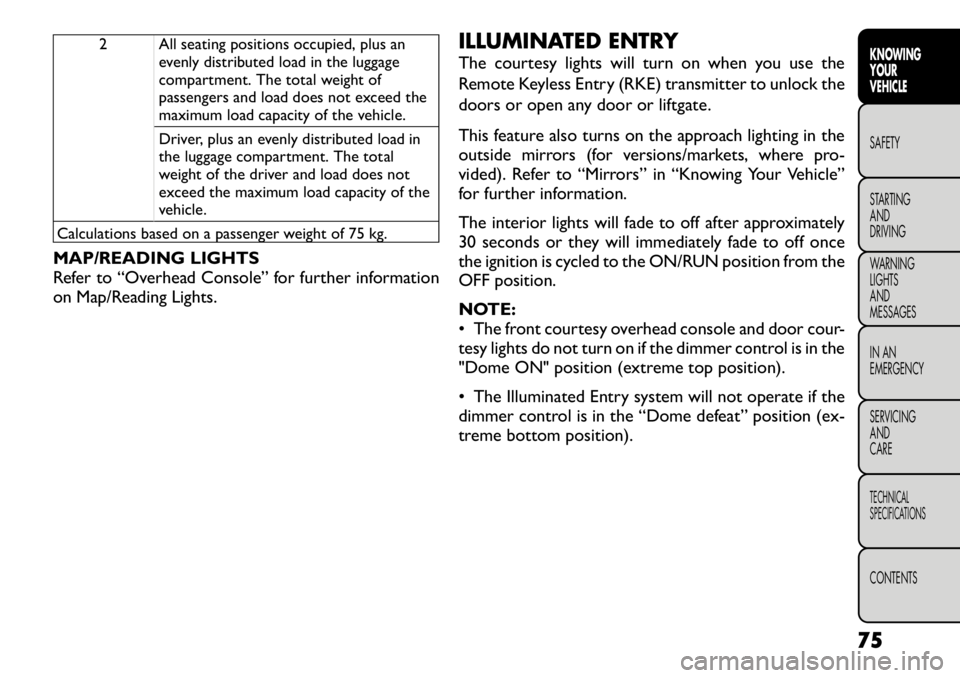
2 All seating positions occupied, plus anevenly distributed load in the luggage
compartment. The total weight of
passengers and load does not exceed the
maximum load capacity of the vehicle.
Driver, plus an evenly distributed load in
the luggage compartment. The total
weight of the driver and load does not
exceed the maximum load capacity of the
vehicle.
Calculations based on a passenger weight of 75 kg.
MAP/READING LIGHTS
Refer to “Overhead Console” for further information
on Map/Reading Lights. ILLUMINATED ENTRY
The courtesy lights will turn on when you use the
Remote Keyless Entry (RKE) transmitter to unlock the
doors or open any door or liftgate.
This feature also turns on the approach lighting in the
outside mirrors (for versions/markets, where pro-
vided). Refer to “Mirrors” in “Knowing Your Vehicle”
for further information.
The interior lights will fade to off after approximately
30 seconds or they will immediately fade to off once
the ignition is cycled to the ON/RUN position from the
OFF position.
NOTE:
• The front courtesy overhead console and door cour-
tesy lights do not turn on if the dimmer control is in the
"Dome ON" position (extreme top position).
• The Illuminated Entry system will not operate if the
dimmer control is in the “Dome defeat” position (ex-
treme bottom position).
75
KNOWING
YOURVEHICLESAFETY
STARTING ANDDRIVING
WARNING LIGHTSAND
MESSAGES
IN AN
EMERGENCY
SERVICING AND
CARETECHNICAL
SPECIFICATIONSCONTENTS
Page 118 of 332
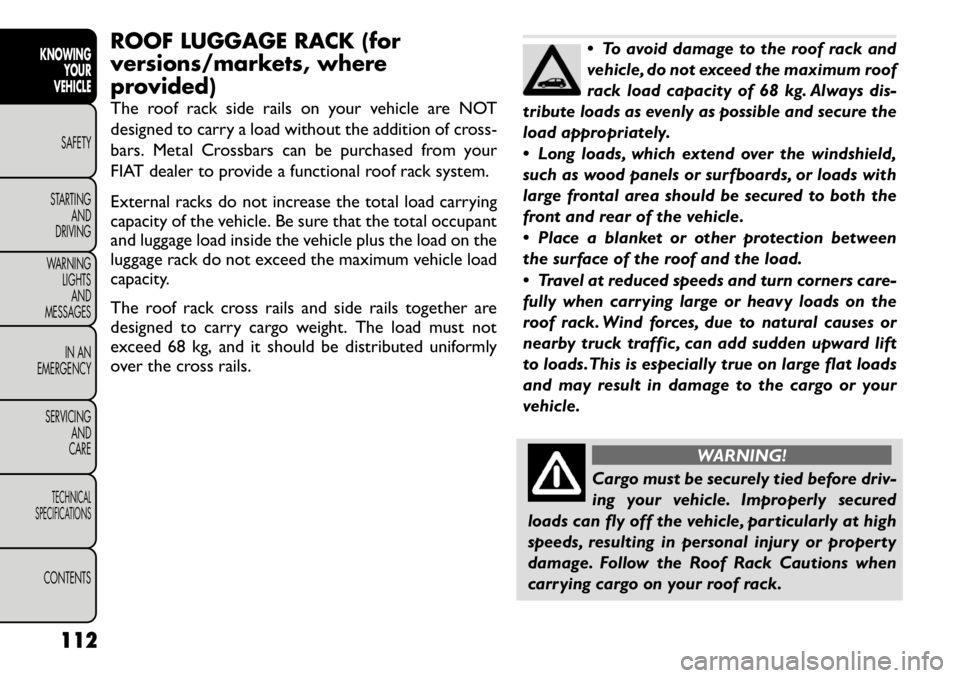
ROOF LUGGAGE RACK (for
versions/markets, where
provided)
The roof rack side rails on your vehicle are NOT
designed to carry a load without the addition of cross-
bars. Metal Crossbars can be purchased from your
FIAT dealer to provide a functional roof rack system.
External racks do not increase the total load carrying
capacity of the vehicle. Be sure that the total occupant
and luggage load inside the vehicle plus the load on the
luggage rack do not exceed the maximum vehicle load
capacity.
The roof rack cross rails and side rails together are
designed to carry cargo weight. The load must not
exceed 68 kg, and it should be distributed uniformly
over the cross rails.
To avoid damage to the roof rack and
vehicle, do not exceed the maximum roof
rack load capacity of 68 kg. Always dis-
tribute loads as evenly as possible and secure the
load appropriately.
Long loads, which extend over the windshield,
such as wood panels or surfboards, or loads with
large frontal area should be secured to both the
front and rear of the vehicle.
Place a blanket or other protection between
the surface of the roof and the load.
Travel at reduced speeds and turn corners care-
fully when carrying large or heavy loads on the
roof rack. Wind forces, due to natural causes or
nearby truck traffic , can add sudden upward lift
to loads.This is especially true on large flat loads
and may result in damage to the cargo or your
vehicle.
WARNING!
Cargo must be securely tied before driv-
ing your vehicle. Improperly secured
loads can fly off the vehicle, particularly at high
speeds, resulting in personal injury or property
damage. Follow the Roof Rack Cautions when
carrying cargo on your roof rack.
112
KNOWING YOUR
VEHICLE
SAFETY
STARTING AND
DRIVING
WARNING LIGHTSAND
MESSAGES
IN AN
EMERGENCY
SERVICING AND
CARETECHNICAL
SPECIFICATIONSCONTENTS
Page 219 of 332
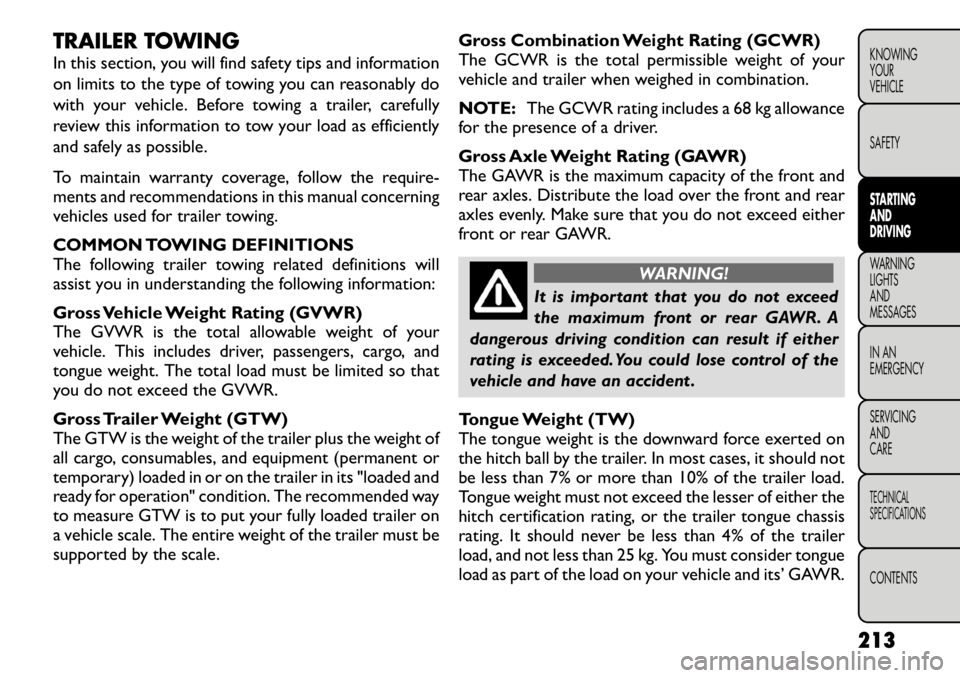
TRAILER TOWING
In this section, you will find safety tips and information
on limits to the type of towing you can reasonably do
with your vehicle. Before towing a trailer, carefully
review this information to tow your load as efficiently
and safely as possible.
To maintain warranty coverage, follow the require-
ments and recommendations in this manual concerning
vehicles used for trailer towing.
COMMON TOWING DEFINITIONS
The following trailer towing related definitions will
assist you in understanding the following information:
Gross Vehicle Weight Rating (GVWR)
The GVWR is the total allowable weight of your
vehicle. This includes driver, passengers, cargo, and
tongue weight. The total load must be limited so that
you do not exceed the GVWR.
Gross Trailer Weight (GTW)
The GTW is the weight of the trailer plus the weight of
all cargo, consumables, and equipment (permanent or
temporary) loaded in or on the trailer in its "loaded and
ready for operation" condition. The recommended way
to measure GTW is to put your fully loaded trailer on
a vehicle scale. The entire weight of the trailer must be
supported by the scale.Gross Combination Weight Rating (GCWR)
The GCWR is the total permissible weight of your
vehicle and trailer when weighed in combination.
NOTE:
The GCWR rating includes a 68 kg allowance
for the presence of a driver.
Gross Axle Weight Rating (GAWR)
The GAWR is the maximum capacity of the front and
rear axles. Distribute the load over the front and rear
axles evenly. Make sure that you do not exceed either
front or rear GAWR.
WARNING!
It is important that you do not exceed
the maximum front or rear GAWR. A
dangerous driving condition can result if either
rating is exceeded. You could lose control of the
vehicle and have an accident .
Tongue Weight (TW)
The tongue weight is the downward force exerted on
the hitch ball by the trailer. In most cases, it should not
be less than 7% or more than 10% of the trailer load.
Tongue weight must not exceed the lesser of either the
hitch certification rating, or the trailer tongue chassis
rating. It should never be less than 4% of the trailer
load, and not less than 25 kg. You must consider tongue
load as part of the load on your vehicle and its’ GAWR.
213
KNOWING
YOURVEHICLE SAFETYSTARTING ANDDRIVINGWARNING LIGHTSAND
MESSAGES
IN AN
EMERGENCY
SERVICING AND
CARETECHNICAL
SPECIFICATIONSCONTENTS
Page 224 of 332
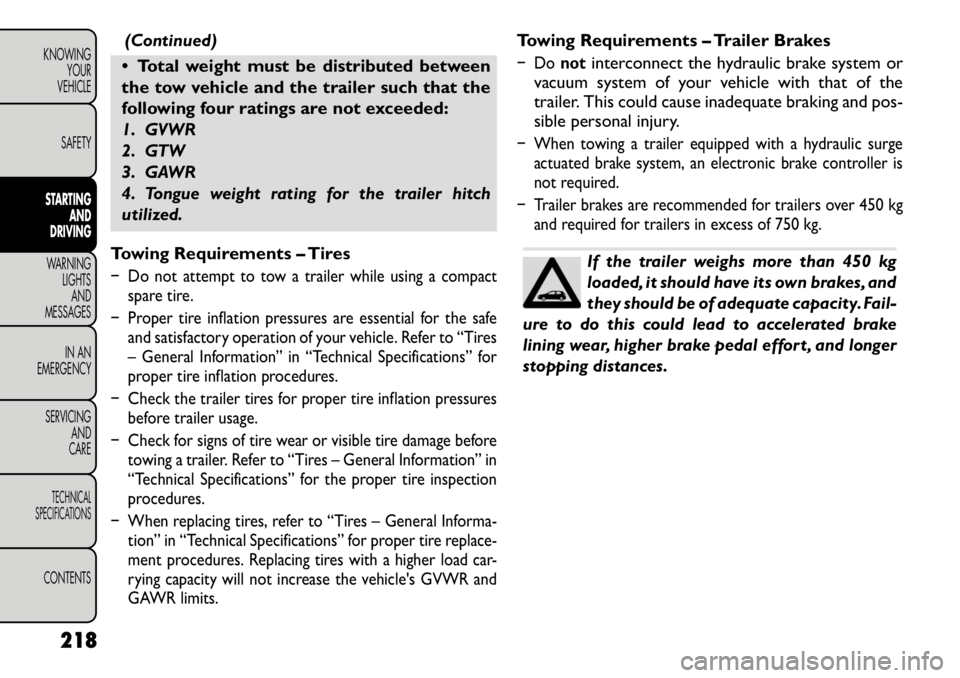
(Continued)
Total weight must be distributed between
the tow vehicle and the trailer such that the
following four ratings are not exceeded:
1. GVWR
2. GTW
3. GAWR
4. Tongue weight rating for the trailer hitch
utilized.
Towing Requirements – Tires� Do not attempt to tow a trailer while using a compact spare tire.
� Proper tire inflation pressures are essential for the safe and satisfactory operation of your vehicle. Refer to “Tires
– General Information” in “Technical Specifications” for
proper tire inflation procedures.
� Check the trailer tires for proper tire inflation pressures before trailer usage.
� Check for signs of tire wear or visible tire damage before towing a trailer. Refer to “Tires – General Information” in
“Technical Specifications” for the proper tire inspection
procedures.
� When replacing tires, refer to “Tires – General Inf orma-
tion” in “Technical Specifications” for proper tire replace-
ment procedures. Replacing tires with a higher load car-
rying capacity will not increase the vehicle's GVWR and
GAWR limits.
Towing Requirements – Trailer Brakes� Do not
interconnect the hydraulic brake system or
vacuum system of your vehicle with that of the
trailer. This could cause inadequate braking and pos-
sible personal injury.
� When towing a trailer equipped with a hydraulic surge actuated brake system, an electronic brake controller is
not required.
� Trailer brakes are recommended for trailers over 450 kg and required for trailers in excess of 750 kg.
If the trailer weighs more than 450 kg
loaded, it should have its own brakes, and
they should be of adequate capacity. Fail-
ure to do this could lead to accelerated brake
lining wear, higher brake pedal effort , and longer
stopping distances.
218
KNOWING YOUR
VEHICLE
SAFETYSTARTING AND
DRIVINGWARNING LIGHTSAND
MESSAGES
IN AN
EMERGENCY
SERVICING AND
CARETECHNICAL
SPECIFICATIONSCONTENTS
Page 299 of 332
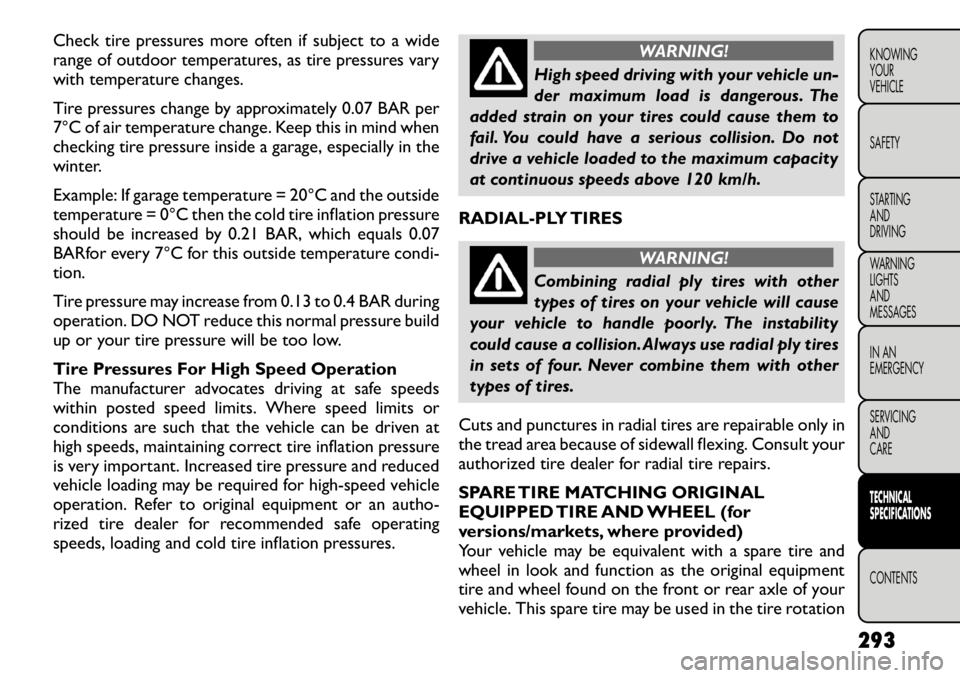
Check tire pressures more often if subject to a wide
range of outdoor temperatures, as tire pressures vary
with temperature changes.
Tire pressures change by approximately 0.07 BAR per
7°C of air temperature change. Keep this in mind when
checking tire pressure inside a garage, especially in the
winter.
Example: If garage temperature = 20°C and the outside
temperature = 0°C then the cold tire inflation pressure
should be increased by 0.21 BAR, which equals 0.07
BARfor every 7°C for this outside temperature condi-tion.
Tire pressure may increase from 0.13 to 0.4 BAR during
operation. DO NOT reduce this normal pressure build
up or your tire pressure will be too low.
Tire Pressures For High Speed Operation
The manufacturer advocates driving at safe speeds
within posted speed limits. Where speed limits or
conditions are such that the vehicle can be driven at
high speeds, maintaining correct tire inflation pressure
is very important. Increased tire pressure and reduced
vehicle loading may be required for high-speed vehicle
operation. Refer to original equipment or an autho-
rized tire dealer for recommended safe operating
speeds, loading and cold tire inflation pressures.
WARNING!
High speed driving with your vehicle un-
der maximum load is dangerous. The
added strain on your tires could cause them to
fail. You could have a serious collision. Do not
drive a vehicle loaded to the maximum capacity
at continuous speeds above 120 km/h.
RADIAL-PLY TIRES
WARNING!
Combining radial ply tires with other
types of tires on your vehicle will cause
your vehicle to handle poorly. The instability
could cause a collision. Always use radial ply tires
in sets of four. Never combine them with other
types of tires.
Cuts and punctures in radial tires are repairable only in
the tread area because of sidewall flexing. Consult your
authorized tire dealer for radial tire repairs.
SPARE TIRE MATCHING ORIGINAL
EQUIPPED TIRE AND WHEEL (for
versions/markets, where provided)
Your vehicle may be equivalent with a spare tire and
wheel in look and function as the original equipment
tire and wheel found on the front or rear axle of your
vehicle. This spare tire may be used in the tire rotation 293
KNOWING
YOURVEHICLE SAFETY
STARTING ANDDRIVING
WARNING LIGHTSAND
MESSAGES
IN AN
EMERGENCY
SERVICING AND
CARETECHNICAL
SPECIFICATIONSCONTENTS
Page 303 of 332
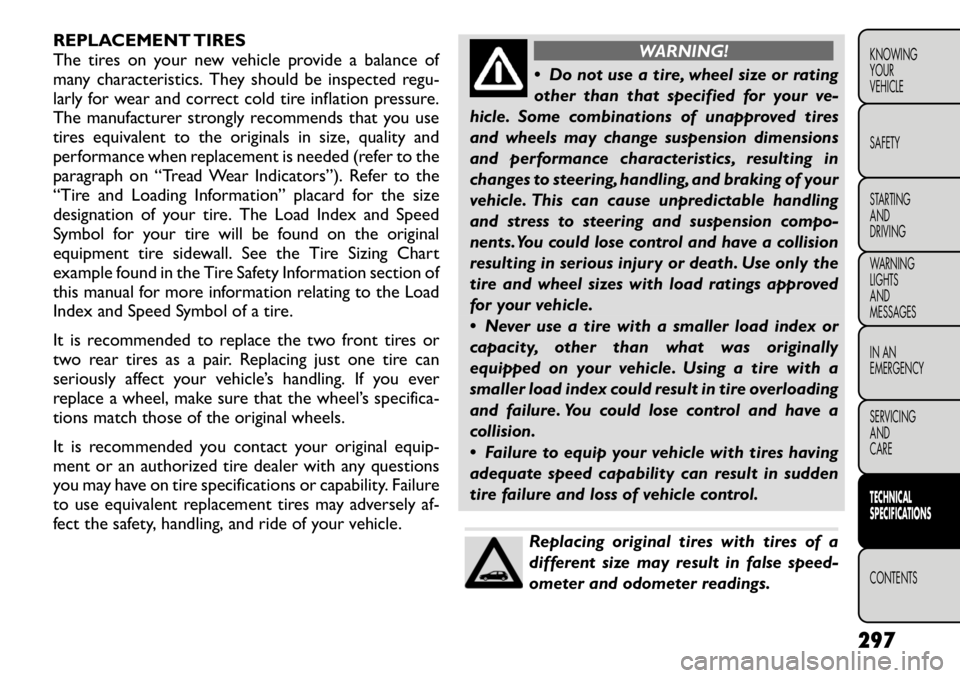
REPLACEMENT TIRES
The tires on your new vehicle provide a balance of
many characteristics. They should be inspected regu-
larly for wear and correct cold tire inflation pressure.
The manufacturer strongly recommends that you use
tires equivalent to the originals in size, quality and
performance when replacement is needed (refer to the
paragraph on “Tread Wear Indicators”). Refer to the
“Tire and Loading Information” placard for the size
designation of your tire. The Load Index and Speed
Symbol for your tire will be found on the original
equipment tire sidewall. See the Tire Sizing Chart
example found in the Tire Safety Information section of
this manual for more information relating to the Load
Index and Speed Symbol of a tire.
It is recommended to replace the two front tires or
two rear tires as a pair. Replacing just one tire can
seriously affect your vehicle’s handling. If you ever
replace a wheel, make sure that the wheel’s specifica-
tions match those of the original wheels.
It is recommended you contact your original equip-
ment or an authorized tire dealer with any questions
you may have on tire specifications or capability. Failure
to use equivalent replacement tires may adversely af-
fect the safety, handling, and ride of your vehicle.
WARNING!
Do not use a tire, wheel size or rating
other than that specified for your ve-
hicle. Some combinations of unapproved tires
and wheels may change suspension dimensions
and performance characteristics, resulting in
changes to steering, handling, and braking of your
vehicle. This can cause unpredictable handling
and stress to steering and suspension compo-
nents.You could lose control and have a collision
resulting in serious injury or death. Use only the
tire and wheel sizes with load ratings approved
for your vehicle.
Never use a tire with a smaller load index or
capacity, other than what was originally
equipped on your vehicle. Using a tire with a
smaller load index could result in tire overloading
and failure. You could lose control and have a
collision.
Failure to equip your vehicle with tires having
adequate speed capability can result in sudden
tire failure and loss of vehicle control.Replacing original tires with tires of a
different size may result in false speed-
ometer and odometer readings.
297
KNOWING
YOURVEHICLE SAFETY
STARTING ANDDRIVING
WARNING LIGHTSAND
MESSAGES
IN AN
EMERGENCY
SERVICING AND
CARETECHNICAL
SPECIFICATIONSCONTENTS
Page 314 of 332
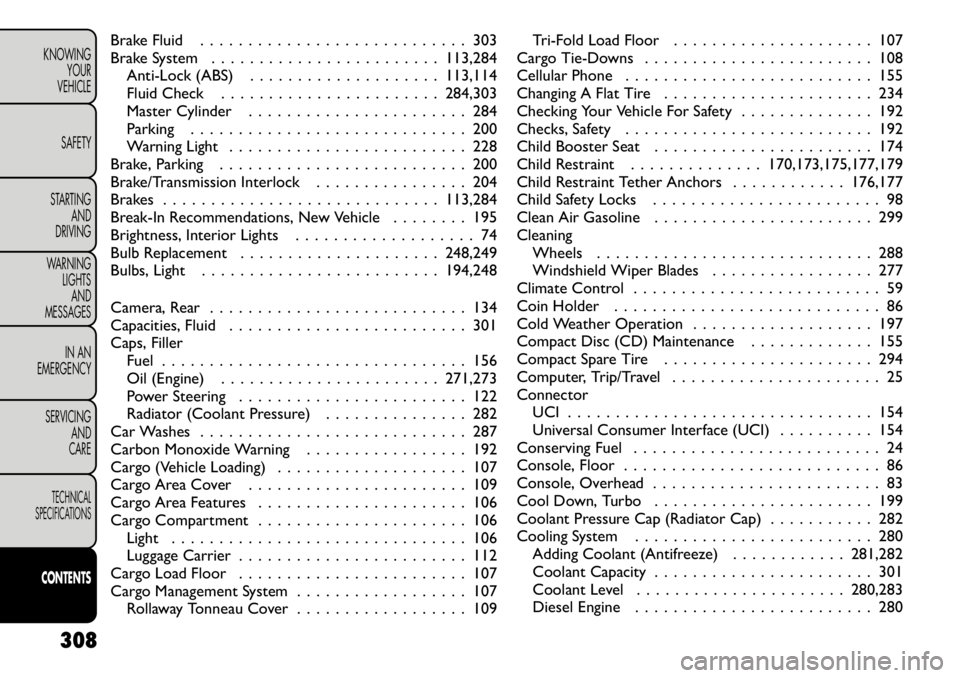
Brake Fluid . . . . . . . . . . . . . . . . . . . . . . . . . . . . 303
Brake System . . . . . . . . . . . . . . . . . . . . . . . . 113,284Anti-Lock (ABS) . . . . . . . . . . . . . . . . . . . . 113,114
Fluid Check . . . . . . . . . . . . . . . . . . . . . . . 284,303
Master Cylinder . . . . . . . . . . . . . . . . . . . . . . . 284
Parking . . . . . . . . . . . . . . . . . . . . . . . . . . . . . 200
Warning Light . . . . . . . . . . . . . . . . . . . . . . . . . 228
Brake, Parking . . . . . . . . . . . . . . . . . . . . . . . . . . 200
Brake/Transmission Interlock . . . . . . . . . . . . . . . . 204
Brakes . . . . . . . . . . . . . . . . . . . . . . . . . . . . . 113,284
Break-In Recommendations, New Vehicle . . . . . . . . 195
Brightness, Interior Lights . . . . . . . . . . . . . . . . . . . 74
Bulb Replacement . . . . . . . . . . . . . . . . . . . . . 248,249
Bulbs, Light . . . . . . . . . . . . . . . . . . . . . . . . . 194,248
Camera, Rear . . . . . . . . . . . . . . . . . . . . . . . . . . . 134
Capacities, Fluid . . . . . . . . . . . . . . . . . . . . . . . . . 301
Caps, Filler Fuel . . . . . . . . . . . . . . . . . . . . . . . . . . . . . . . . 156
Oil (Engine) . . . . . . . . . . . . . . . . . . . . . . . 271,273
Power Steering . . . . . . . . . . . . . . . . . . . . . . . . 122
Radiator (Coolant Pressure) . . . . . . . . . . . . . . . 282
Car Washes . . . . . . . . . . . . . . . . . . . . . . . . . . . . 287
Carbon Monoxide Warning . . . . . . . . . . . . . . . . . 192
Cargo (Vehicle Loading) . . . . . . . . . . . . . . . . . . . . 107
Cargo Area Cover . . . . . . . . . . . . . . . . . . . . . . . 109
Cargo Area Features . . . . . . . . . . . . . . . . . . . . . . 106
Cargo Compartment . . . . . . . . . . . . . . . . . . . . . . 106 Light . . . . . . . . . . . . . . . . . . . . . . . . . . . . . . . 106
Luggage Carrier . . . . . . . . . . . . . . . . . . . . . . . . 112
Cargo Load Floor . . . . . . . . . . . . . . . . . . . . . . . . 107
Cargo Management System . . . . . . . . . . . . . . . . . . 107 Rollaway Tonneau Cover . . . . . . . . . . . . . . . . . . 109 Tri-Fold Load Floor . . . . . . . . . . . . . . . . . . . . . 107
Cargo Tie-Downs . . . . . . . . . . . . . . . . . . . . . . . . 108
Cellular Phone . . . . . . . . . . . . . . . . . . . . . . . . . . 155
Changing A Flat Tire . . . . . . . . . . . . . . . . . . . . . . 234
Checking Your Vehicle For Safety . . . . . . . . . . . . . . 192
Checks, Safety . . . . . . . . . . . . . . . . . . . . . . . . . . 192
Child Booster Seat . . . . . . . . . . . . . . . . . . . . . . . 174
Child Restraint . . . . . . . . . . . . . . 170,173,175,177,179
Child Restraint Tether Anchors . . . . . . . . . . . . 176,177
Child Safety Locks . . . . . . . . . . . . . . . . . . . . . . . . 98
Clean Air Gasoline . . . . . . . . . . . . . . . . . . . . . . . 299Cleaning Wheels . . . . . . . . . . . . . . . . . . . . . . . . . . . . . 288
Windshield Wiper Blades . . . . . . . . . . . . . . . . . 277
Climate Control . . . . . . . . . . . . . . . . . . . . . . . . . . 59
Coin Holder . . . . . . . . . . . . . . . . . . . . . . . . . . . . 86
Cold Weather Operation . . . . . . . . . . . . . . . . . . . 197
Compact Disc (CD) Maintenance . . . . . . . . . . . . . 155
Compact Spare Tire . . . . . . . . . . . . . . . . . . . . . . 294
Computer, Trip/Travel . . . . . . . . . . . . . . . . . . . . . . 25
Connector UCI . . . . . . . . . . . . . . . . . . . . . . . . . . . . . . . . 154
Universal Consumer Interface (UCI) . . . . . . . . . . 154
Conserving Fuel . . . . . . . . . . . . . . . . . . . . . . . . . . 24
Console, Floor . . . . . . . . . . . . . . . . . . . . . . . . . . . 86
Console, Overhead . . . . . . . . . . . . . . . . . . . . . . . . 83
Cool Down, Turbo . . . . . . . . . . . . . . . . . . . . . . . 199
Coolant Pressure Cap (Radiator Cap) . . . . . . . . . . . 282
Cooling System . . . . . . . . . . . . . . . . . . . . . . . . . 280 Adding Coolant (Antifreeze) . . . . . . . . . . . . 281,282
Coolant Capacity . . . . . . . . . . . . . . . . . . . . . . . 301
Coolant Level . . . . . . . . . . . . . . . . . . . . . . 280,283
Diesel Engine . . . . . . . . . . . . . . . . . . . . . . . . . 280
308
KNOWING YOUR
VEHICLE
SAFETY
STARTING AND
DRIVING
WARNING LIGHTSAND
MESSAGES
IN AN
EMERGENCY
SERVICING AND
CARETECHNICAL
SPECIFICATIONSCONTENTS